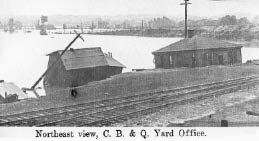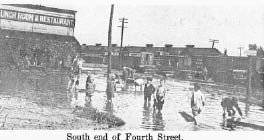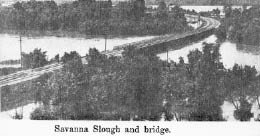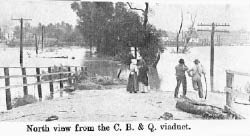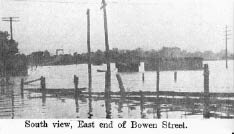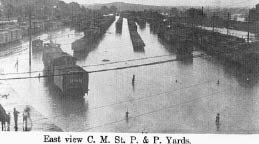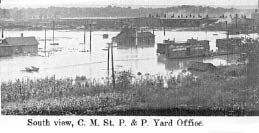
Discover rewarding casino experiences. 

Please Don't Quote Me PART II — Business on and from the Mississippi River was prolific and profitable in the early decades of Savanna’s settlement because of its trade in wood and as a depot and trading place in and out as a port. Then the method of powering boats changed from wood and the way of transportation with it. |
The woodcutters moved on to other jobs or went to California with the Gold Rush. Oh, yes, freighters, rafts of logs, passenger boats and smaller boats were still making their way along the Big River but they evolved also into tow boats, runabouts, leisure, pontoon house boats and many more as the twentieth century moved time onward. Passenger boats became excursion boats full of fun-seekers at gambling, vaudeville shows, dance bands and sightseeing. Calliopes thunked slightly off-key as the excursions splashed their way mid-current to announce their presence. Each boat had a distinctive whistle, too, to herald its arrival and passing. Savannans learned to recognize them. Times were a-changin’. Big changes came in transportation mid-nineteenth century with the coming of the railroad. But again Savanna was located at just the right place to receive the rails as it had been for the steamboat stops. Land traffic now made it important not exclusively to water traffic.
As early as 1857 rumor abounded that a railroad would be built from Racine on Lake Michigan diagonally southwest to link with the Mississippi River at Savanna. Two modes of travel would thus be available and the Midwest would boom. Most modern. The Racine and Mississippi Railroad would be the carrier and its name would change several times over the decade just as the companies had over the previous few because of bankruptcies, swindles and poor investments. Not until 1862 wold the tracks finally be set into Savanna, their iron rails passing through Carroll, Stephenson, Winnebago, counties in Illinois and opening up brand new markets and two new depots, Shannon and Lanark in Carroll alone were born. It couldn’t have come at a better time what with the Civil War in full roar. The acres and acres of wheat that grew so thickly it had to be harvested before the towns could be platted was needed for bread for the Boys in Blue; beef and pork, the livestock, for rations and markets off everywhere. Elation at the ceremony at the Mississippi, however was tempered by sadness at the news of those killed in battle.
Savanna was a natural as a terminal for railroads with its broad savanna beneath the towering bluffs to spread out the several rail lines from directions and places new to the ears. Besides the fishing that went on, too, marinas developed and leisure became another market ... local and tourists. The Savanna Boat Club with its Commodore organized before the turn-of-the century, was only the beginning (last week). Not only did river and rail traffic change but a third element entered society ... Automobiles and what with the awesome palisades at its back Savanna, naturally, could use them for parks and recreation. Especially with the Mississippi at their foot. Roads were mapped, improved, signage pointed to Northwest Illinois. Routes began to have names such as “Indian Head” and “River Road” to entice the traveler and the local supporter who made a Sunday drive part of the modern day routine; Cafes, hotels, taverns appeared to host the new market, tourism. Ferries moved traffic ‘cross the river but it was soon agitated that a bridge was necessary although it wasn’t until 1930 that one linked Illinois and Iowa assuring the Northwest that it could compete with Dubuque, Clinton or Rock Island. And through traffic from the East or West helped the county’s economy for certain.
Meanwhile, at the start of the second decade of the twentieth century Savanna was proud of its many modern accomplishments in technology. It had a telephone exchange, two artesian wells for a water system and the city council had just okayed installing a sewerage system. Electric lights were subscribed to from a private company. Hard brick streets were being added to, cement sidewalks were slowly replacing the wood plank ones. These like the streets, were being measured in miles not just footage. Brick buildings were outnumbering the old-timey false front wooden frame ones. Importantly, there was employment. Two rail lines provided jobs for most of the male population. Estimate in 1912 would report that the Milwaukee rail company alone paid out a half million dollars in wages annually.
The ornate mansions atop the bluff, some to resemble the once fancy steamboats, were now owned by well-to-do businessmen, captains of industry and professions, not just steamboat captains. By 1910 and “circa” years the steamboat people had passed on mostly, passed on to the Great Sky Blue River of Timelessness in the Great Beyond. Large labor forces were used by the Chicago, Milwaukee, St. Paul company that had evolved from the R&M, and the Chicago, Burlington and Quincy that had laid track into town by 1885 to so enlarge the rail yards that roundhouses had to be constructed to make the terminal even more efficient. What rail traffic there was in such number. A railroad bridge constructed 1879-’80 was vital to the growth of the system and the town. Its importance could hardly be estimated. Until it was built engines (and people) were ferried across the Mississippi on tracks laid on the ice in winter. Imagine the safety/security issues. Yes, Savanna faced many problems because of its location in the development of its “benefits” but it seemed to handle them all practically. Even to the purchase in 1917 of 13,000 acres of land north of it by the federal government for use as an ammunition proving ground.
There, eventually, not only was the male population involved on the labor force as mentioned in 1912 at the railroads but women, too, were hired. We do have to remind you, however, that the Milwaukee rail company did hire women as early as 1917—to clean the coaches and the engines!!!! The Proving Ground wold eventually vie with the rail companies for labor force but yet in the beginning of the second decade of the twentieth century, rails ruled. The many shining metal rails, the roundhouses and the start of construction of larger, more imposing depots by both companies to replace the older, well-used ones were all the talk. Down there where once the savanna grass grew thick and tall and was cut in season to be baled for hay and hauled away in the tons, the modern day prevailed.
There were hotels down there for employees passing through, just as there were hotels downtown. Barber Shops, cafes, saloons, shoe repair, clothing for railroad employees exclusively could be found. Savanna lived up to its reputation as a “railroad town.” There seemed no end to the possibilities or the growth because issues and problems were efficiently and properly taken care of. Except for one thing. Mother Nature. Although floods of many dimensions and depths occurred over the years at the railport river town one in 1911 came as something of a surprise ... The Burlington yard office was inundated so quickly the men there had to scramble to get out and then walked in water up to their shoulders. The Burlington’s main line tracks gave way unexpectedly, 400 feet of it, it is reported. Johnny Stephens’ lunch room suddenly became flooded there at the end of the turnpike bridge.
These events are pictured in “SAVANNA, YESTERDAY AND TODAY” issued by the Carroll County Genealogical Society, 1979. The pictures here were popular postcards that collectors discover now and then even though ninety-nine years old ... 1911 that sudden flood occurred, trains didn’t run for a week. Something similar to the summer flood of 2010.
There’ve been other floods, of course, but these two, nearly a hundred years to the month apart remind us again that though history repeats itself there’s some things we can’t prepare for no matter how we plan ahead.
|


